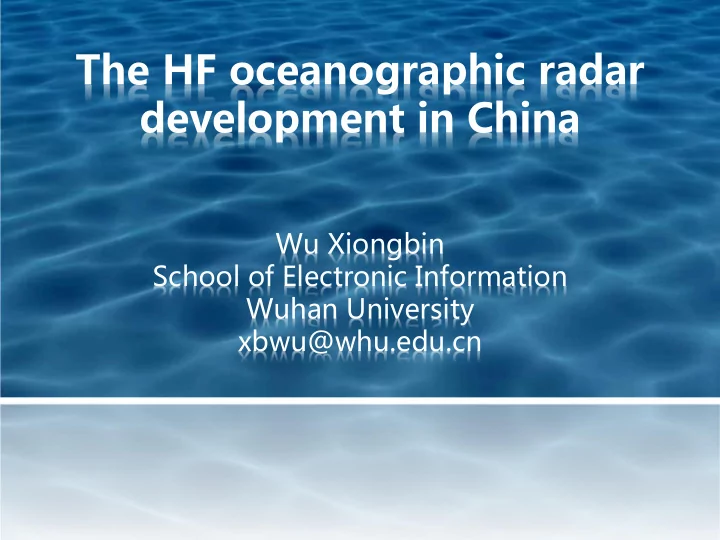

The HF oceanographic radar development in China Wu Xiongbin School of Electronic Information Wuhan University xbwu@whu.edu.cn
Outlines • An overall introduction • Development of the OSMAR HFSWR technique • OSMAR tests and applications • Problems and future work
Introduction • China started the HFSWR (High-Frequency Surface Wave Radar) technology studies on sea state surveillance since 1980’s. – Harbin Institute of Technology – Wuhan University – East China Normal University – Xidian University • Supported by • the National Natural Science Foundation of China • the China National 863 High Technique Project
Introduction • More than 15 HFSWR stations are now operating along the China coastlines • Managed by – the State Oceanic Administration (SOA) – the China Meteorological Administration (CMA)
Wuhan University ~ HF Radar ? • Routine Ionosphere observation began since 1945. • Independently reported the discovery of Equatorial Anomaly on Nature in 1947. • Developed series of ionosphere probing equipments in China. • Ionosphere probing equipments work in HF band. Actually they are HF radars. • OSMAR( O cean S tate M onitoring & A nalyzing R adar) appears naturally when the antenna beam of an ionosphere HF radar is turned from sky to ocean.
Development of the OSMAR HFSWR technique • The Space Physics Department of Wuhan University started the OSMAR series HFSWR development since the late 1980s. • The first prototype OSMAR was tested at the coast of Guangxi Province in 1993. • Motivated by the early CODAR 4-element system.
Development of the OSMAR HFSWR technique • 200km-coverage OSMAR – 7.5MHz FMICW waveform – three intermediate frequency conversion superheterodyne structure – a three-element Yagi transmitting antenna – a receiving array composed of eight linearly-deployed dipole antennas – MUSIC for currents – DBF for wind and wave information
Development of the OSMAR HFSWR technique • Latest OSMAR product features: – automatically calibration of amplitude and phase mismatch between channels. – allowing alternatively frequency- changing among FMICW sweeping frames – full digital receiver techniques – software: C/S (Client/Server) type database architecture
Longhai OSMAR Site
Dongshan OSMAR Site
A-scope display of sea echoes
Doppler spectra of sea echoes
Radio spectrum surveillance
Radial current field
Vector current field
Vector current field
OSMAR Results Wind field Wave field Doppler Spectra Current field 60 Wave Spectra from inversion 50 40 s 2 30 m 值 / 20 谱 10 0 -10 0.02 0.04 0.06 0.08 0.1 0.12 0.14 频 率 /Hz
OSMAR tests and applications • Verification tests conclusions: – (1) temporal and spatial stable surface current field (such as tide field) can be detected by HFSWR with quite high accuracy and reliability; – (2) results from different systems demonstrate different temporal and spatial resolution; – (3) dynamics inversed from the echoes’ second order Doppler spectra (such as wave height, wind velocity, etc.) show poor quality and low reliability compared with current information which is extracted from the first order peaks
OSMAR tests and applications • The work of OSMAR data quality control and feasibility of using these data in oceanographic studies are organized and lead by scholars in Xiamen University. (Zhu D., et al, The Taiwan Straight , 2006)
OSMAR tests and applications Long time-series of OSMAR • surface current data sets were used to decompose the surface current in western part of the Taiwan Strait, and it was found that the surface current there contains mainly two parts: the seasonal variation of the along-shore currents induced by the monsoon and 10cm/s along shore an all-year-long persistent Current when there is no wind stress background northeast flow of about 10cm/s. (Zhu D., et al, Chinese Science Bulletin , 2008)
OSMAR tests and applications The OSMAR sea surface current data was assimilated into a • parallelly computing 3-D numerical oceanic prediction model in the Taiwan Strait together with other multi-sensor ocean data using 4D Variational Data Assimilation method, the errors between predicted and observed data were reduced as much as 32.4% and thus the prediction was greatly improved. SST RMSE. HF Radar current RMSE (Zhang, Ph.D Thesis , 2009)
OSMAR tests and applications The bottom drag coefficient has been estimated from the HF-radar current flow, the drag reduction trend over periodic bathymetry (sand waves) was revealed and new drag coefficient for regional numerical model was proposed. (Wu X. and Li Y., 1 st ORCA , 2012)
HFSWR shoal floor topography Deep Water Shallow Water V p = ( g / k 0 ) 1/2 V p = ( g tanh (k 0 h) / k 0 ) 1/2 h < radio / 4 h ≥ radio / 4
2011.7.1 ~ 8.6 , Wuhan Univ.,Xiamen Univ. and Nanjing Univ.
Beilingzha Site
Taiyangsha Site
Dafenggang Site
Result of shoal floor topography (Li Yan, Zhong Yaozhao, 2012)
Problems and future work • For low HF band radar systems, which are designed to cover more than 100km range, are exposed to intensive natural or artificial radio interferences and noises in the southern China coast areas, thus data quality is hard to be maintained. • Missing of large current information. • Applicability to temporally or spatially complicated currents. • Inversion difficulties concerning about wave and wind field.
HFSWR network test
Recommend
More recommend